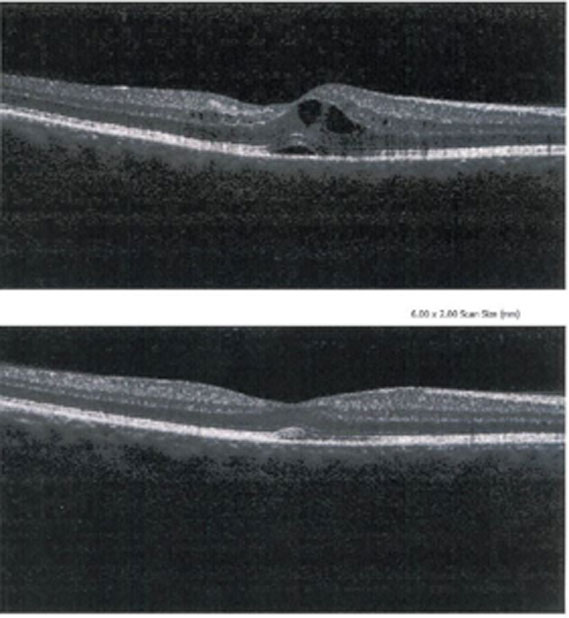BLOG: Putting the ‘me’ in the treatment of CME
One of the more frequent cataract postop complications, cystoid macular edema, requires prompt detection and management for restorative visual acuity. Fortunately, it is generally a straightforward diagnosis, and the first line of management falls within optometry’s scope of practice.
The most common time frame for the onset of cystoid macular edema (CME) is around 1 to 3 months postoperatively. This is why it is critical to do a dilated exam around the month mark.
It is not difficult to hone in on the possibility of CME when a patient has relatively good visual acuity at the 1-day and 1-week postop but then drops a few lines of correctable acuity (usually 20/40 or worse) by the 1-month mark. Acute pseudophakic CME generally has an onset within the first 6 months postoperatively, while the term chronic pseudophakic CME is reserved for the cases lasting longer than 6 months postoperatively.
Although often difficult to visualize funduscopically, CME will appear as intraretinal cystic formation right at the fovea. OCT is a much more sensitive tool to visualize CME and will often show an impressive increase in intraretinal thickness at the macula as well as multiple intraretinal cystic cavities on the cross-sectional scan.

Postoperative CME, sometimes called Irvine-Gass syndrome, is the result of intraretinal capillaries leaking serous exudate into the outer plexiform layer in the macular area. Surgical manipulation of the ocular structures is believed to cause both mechanical/tractional insults to the fovea as well as an upregulation of inflammatory mediators that are responsible for the breakdown of the blood-retina barrier. The failure of these normally tight junctions allows fluid to accumulate in the retinal layers. This exudate collects into small pockets or cysts of fluid that have a very specific appearance on the OCT.
Angiographic and OCT-detected CME have been reported to be as high as 20% in uncomplicated cataract surgery, but the current incidence of visually significant CME is much lower, around 1% to 2% (Boulton et al.). However, the rate of CME can be higher in certain populations who have preexisting ocular pathology. The patients most prone to developing CME following cataract surgery are those who have had prior vein occlusions, epiretinal membranes, uncontrolled systemic vascular disease (diabetes mellitus or hypertension) and those with recent postoperative states (laser, scleral buckle, panretinal photocoagulation, penetrating keratoplasty). Patients who have pre-existing diabetic macular edema or severe diabetic retinopathy are much more prone to developing pseudophakic CME and need to be treated before undergoing cataract surgery. Perioperative complications such as vitreal loss, iris trauma, posterior capsular rupture or an anterior chamber IOL can also result in a higher risk of CME.
There is no universally agreed-upon treatment or prophylaxis for CME, but there are a few options that can be helpful in your prevention and management strategies. In some cases, observation alone may be sufficient — given time, the edema will likely spontaneously resolve. We tend to be proactive and use a combination of topical corticosteroid and nonsteroidal anti-inflammatory drops. Topical prednisolone acetate 1% and ketorolac 0.5% has been shown to improve visual acuity in pseudophakic CME better than with either agent as monotherapy (Boulton et al.). NSAIDS that have been studied and shown to be beneficial in the treatment of CME include: Acular (ketorolac tromethamine 0.5%, Allergan), Voltaren (diclofenac sodium 0.1%, Novartis), Bromday (bromfenac ophthalmic solution 0.09%, Ista) and Nevanac (nepafenac ophthalmic suspension, Alcon). The topical drop is generally administered four times a day for about a month after cataract surgery. For high-risk patients, you can consider placing them on a NSAID for a week prior to surgery. If the CME is resistant to resolution with topical treatment, a sub-Tenon’s steroidal injection can help. Intravitreal corticosteroids and anti-VEGF are more recently being looked at as treatment options for chronic CME resistant to more superficial treatments.
Although the efficacy of oral carbonic anhydrase inhibitors is thought to be useful in the treatment of refractory pseudophakic CME, the treatment is somewhat controversial due to systemic side effects. It is speculated that these medications can help pump fluid out of the retinal pigment epithelium cells and decrease intraretinal fluid.
It is worthwhile to consider what medications your glaucoma patients who exhibit CME postoperatively are on. Prostaglandins, as molecules directly involved in the inflammatory cascade, are the most scrutinized medication class in regard to their role in CME, but timolol and the preservative BAK have also been studied and are also thought to stimulate the inflammatory cascade (Miyake et al., Arcieri et al.). We do not routinely discontinue a patient’s prostaglandin analogue prior to cataract surgery, but it is important to realize if they do go on to develop CME postoperatively, consider switching to a non-prostaglandin to control IOP until the resolution of the CME.
Visual prognosis is usually excellent with resolution of the macular edema, with most patients having full restoration of visual acuity within 6 months. If left untreated, chronic macular edema can cause long-term decrease in visual acuity, color desaturation and degradation of contrast sensitivity.
References:
Arcieri ES, et al. Arch Ophthalmol. 2005;doi:10.1001/archopht.123.2.186.
Boulton M, Saxby LA. Secondary Cataract. In: Yanoff M and Duker JS, eds. Ophthalmology, 4th ed. St Louis: Werner; 2014:627, 630.
Miyake K, et al. J Cataract Refract Surg. 2003;29(9):1800-1810.
